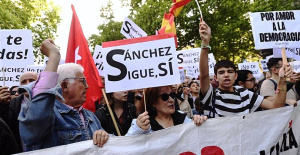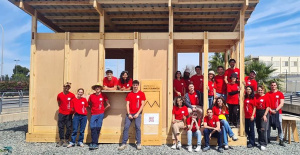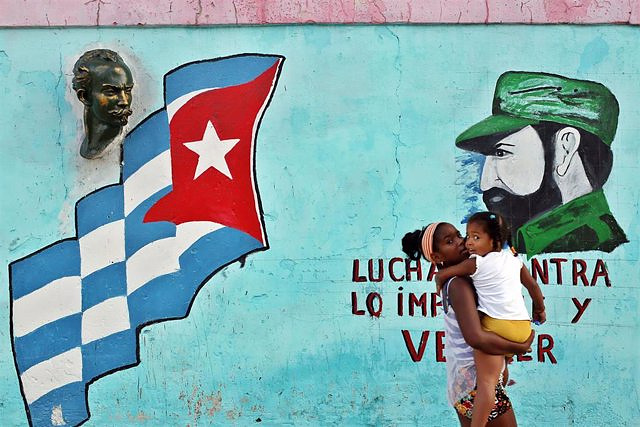A record number of Cubans have arrived in the US in the last year, mostly by land from Mexico
MADRID, 2 Abr. (EUROPA PRESS) -
The worst economic crisis in three decades in Cuba has generated an exodus never seen on the island, despite the fact that in the more than 60 years that have elapsed since the triumph of the Revolution led by Fidel Castro, many Cubans have sought a better life. beyond its borders.
The United States, the traditional destination country for Cuban emigration, has recorded a record number of Cuban arrivals at its borders, essentially by land through Mexico, although there are those who continue to attempt the dangerous journey from the island to the Florida coast.
According to official data, the US Border Patrol recorded during the 2021-2022 fiscal year, which runs from October to September, a record of 224,000 "encounters" with Cuban migrants, a figure that does not directly translate into Cuban migrants, since the same person can make several attempts to cross. The data is maintained in the following months, with more than 44,000 meetings last December.
This figure would mean that around 2% of Cubans have tried to leave the island in the last year, which has already led some experts to even speak of "depopulation" and to call attention to the impact on the future that this may have, given that those who leave are essentially young people and adults of working age and the population of the island is very old.
The data is much higher than that registered in previous migratory waves from the island, due to the short period of time in which it occurred. Thus, after the triumph of the Revolution, it is estimated that some 250,000 Cubans went into exile between 1959 and 1962, while during the so-called Mariel exodus of 1980 there were some 125,000. During the so-called 'Freedom Flights' between 1965 and 1973 some 300,000 people left Cuba while in the rafters crisis of 1994 there were more than 30,000).
Those who arrive by land from Mexico are joined by those who do so by sea. Since last October 1, the US Coast Guard has intercepted 5,862 Cubans in various types of vessels in their attempt to reach the coasts of the United States, a figure that contrasts with the 6,182 interceptions of Cubans that occurred in fiscal year 2022. the 838 of 2021 and the 49 of 2020.
The increase in the numbers of those who go to sea to reach Florida has also translated into an increase in the number of deaths. According to data from the International Organization for Migration (IOM), since 2014 a total of 425 people have died or disappeared on the route from Cuba to the United States, 202 of them in 2022, a record number that contrasts with the 66 in 2022. So far this year, 53 dead or missing have already been counted.
The reason for this exodus is none other than the fact that "Cuba is facing the worst economic crisis since the Special Period," says economist Carmelo Mesa-Lago in an article published by the Cuban Research Institute of Florida International University, in reference to the crisis that followed the fall of the Soviet Union in 1991.
In the absence of more up-to-date data, the island's GDP fell by 10.9% in 2020, the worst record after the 14.9% drop that occurred in 1993. For 2022, the Cuban government had set a growth rate of 4 %, but finally it would have been around 2%, although it is not an official figure, highlights this economist.
Among the reasons for this crisis, Mesa-Lago identifies the inefficiency of the island's economic system, the bad economic situation that Venezuela is going through, on which the Cuban economy depends to a large extent, as well as the "strong sanctions imposed by the president Donald Trump, who reversed the rapprochement process initiated by President Barack Obama and reinforced the embargo" imposed decades ago.
Added to this was the impact of the COVID-19 pandemic, which reduced tourism, one of the main sources of income, and now the war in Ukraine, which has brought with it a rise in the price of food and oil.
Nor does the political context help. "The government continues to repress and punish virtually all forms of dissent and public criticism," Human Rights Watch (HRW) underlined in its recent annual report. "Government repression and the apparent lack of will to address the underlying causes that drove people onto the streets" in July 2021 "have forced Cubans to leave the country in unprecedented numbers," he stresses.
The exodus to the United States has been prompted by various reasons. One of the key factors has been the decision in November 2021 by Nicaragua to abolish the need for a visa for Cubans. Since then, many have chosen to fly to the Central American country and start a long journey from there, but avoid the dangerous Darién Gap between Colombia and Panama, another of the main migration routes to Mexico.
The fact that more Cubans are now being accepted has also apparently contributed. "Before (Joe) Biden, the refugee status recognition rate was 45 to 48 percent and now it is 55 percent," said Ariel Ruiz, from the US think tank Migration Policy Institute, in statements to Deutsche Welle. "Although it is not drastic, the figures seem to indicate that there has been a change to speed up the processes for Cubans," he adds.
To try to contain arrivals, the Biden Administration approved a new policy in January under which 30,000 migrants from Cuba, as well as from Venezuela, Haiti and Nicaragua will be accepted per month through the 'parole' system, under which they will need a sponsor in the United States.
After the background check, these migrants will be able to remain in the country to work for a period of two years while they complete the procedure for a period of two years, while they wait to complete the procedures to obtain legal permanent residence.
Those who arrive at the US borders through other procedures will not be able to access this process and will be immediately expelled to Mexico, which will have to accept the return of 30,000 of them per month, according to the measure adopted on January 5. These people will not be able to re-enter the United States for a period of five years.
But although the United States is the main destination for Cubans leaving the island, it is not the only one. Since they have to cross Mexico on their journey, a growing number have chosen to seek asylum in the Aztec country.
In 2022, just over 18,000 Cubans requested refugee status in the country --the second nationality behind Honduras--, a figure with almost 8,300 in 2021 and 5,700 in 2020, according to data from the Mexican Aid Commission to the Refugee (COMAR).
Arrivals to the EU have also doubled, although in this case the figures are much more modest. Thus, according to data from the EU Agency for Asylum, in 2022 there were 3,347 asylum applications compared to 1,765. Of these, only around 9% receive a positive response.
Among those who have come to the EU seeking refuge, many have done so via the Western Balkans route, taking advantage of the visa waiver that exists with Serbia, as well as Russia. According to a survey carried out by the IOM last summer, Cubans represented 6.9% of the migrants en route through Bosnia, a neighboring country of Serbia.

 Exploring Cardano: Inner Workings and Advantages of this Cryptocurrency
Exploring Cardano: Inner Workings and Advantages of this Cryptocurrency Seville.- Economy.- Innova.- STSA inaugurates its new painting and sealing hangar in San Pablo, for 18 million
Seville.- Economy.- Innova.- STSA inaugurates its new painting and sealing hangar in San Pablo, for 18 million Innova.- More than 300 volunteers join the Andalucía Compromiso Digital network in one month to facilitate access to ICT
Innova.- More than 300 volunteers join the Andalucía Compromiso Digital network in one month to facilitate access to ICT Innova.-AMP.- Ayesa acquires 51% of Sadiel, which will create new technological engineering products and expand markets
Innova.-AMP.- Ayesa acquires 51% of Sadiel, which will create new technological engineering products and expand markets Abascal (Vox) criticizes that Sánchez is "victimizing" himself and calls for elections after his possible resignation
Abascal (Vox) criticizes that Sánchez is "victimizing" himself and calls for elections after his possible resignation Carlos Alcaraz reaches the round of 16 in Madrid without breaking a sweat
Carlos Alcaraz reaches the round of 16 in Madrid without breaking a sweat Some 5,000 people demonstrate in front of Congress for democracy, hours before Sánchez's decision
Some 5,000 people demonstrate in front of Congress for democracy, hours before Sánchez's decision STATEMENT: Intelligent systems used in the construction of the deepest underwater tunnel in China
STATEMENT: Intelligent systems used in the construction of the deepest underwater tunnel in China How Blockchain in being used to shape the future
How Blockchain in being used to shape the future Not just BTC and ETH: Here Are Some More Interesting Coins Worth Focusing on
Not just BTC and ETH: Here Are Some More Interesting Coins Worth Focusing on UPV students build a prototype of a wooden house to move to Equatorial Guinea
UPV students build a prototype of a wooden house to move to Equatorial Guinea The UA opens the call for the Impulso 2024 Awards for the best innovative business initiatives
The UA opens the call for the Impulso 2024 Awards for the best innovative business initiatives ALI, virtual assistant from Alicante, internationally recognized by the OECD
ALI, virtual assistant from Alicante, internationally recognized by the OECD Retrópolis brings the golden age of video games and computing to the UPV
Retrópolis brings the golden age of video games and computing to the UPV A million people demonstrate in France against Macron's pension reform
A million people demonstrate in France against Macron's pension reform Russia launches several missiles against "critical infrastructure" in the city of Zaporizhia
Russia launches several missiles against "critical infrastructure" in the city of Zaporizhia A "procession" remembers the dead of the Calabria shipwreck as bodies continue to wash up on the shore
A "procession" remembers the dead of the Calabria shipwreck as bodies continue to wash up on the shore Prison sentences handed down for three prominent Hong Kong pro-democracy activists
Prison sentences handed down for three prominent Hong Kong pro-democracy activists ETH continues to leave trading platforms, Ethereum balance on exchanges lowest in 3 years
ETH continues to leave trading platforms, Ethereum balance on exchanges lowest in 3 years Investors invest $450 million in Consensys, Ethereum incubator now valued at $7 billion
Investors invest $450 million in Consensys, Ethereum incubator now valued at $7 billion Alchemy Integrates Ethereum L2 Product Starknet to Enhance Web3 Scalability at a Price 100x Lower Than L1 Fees
Alchemy Integrates Ethereum L2 Product Starknet to Enhance Web3 Scalability at a Price 100x Lower Than L1 Fees Mining Report: Bitcoin's Electricity Consumption Declines by 25% in Q1 2022
Mining Report: Bitcoin's Electricity Consumption Declines by 25% in Q1 2022 Oil-to-Bitcoin Mining Firm Crusoe Energy Systems Raised $505 Million
Oil-to-Bitcoin Mining Firm Crusoe Energy Systems Raised $505 Million Microbt reveals the latest Bitcoin mining rigs -- Machines produce up to 126 TH/s with custom 5nm chip design
Microbt reveals the latest Bitcoin mining rigs -- Machines produce up to 126 TH/s with custom 5nm chip design Bitcoin's Mining Difficulty Hits a Lifetime High, With More Than 90% of BTC Supply Issued
Bitcoin's Mining Difficulty Hits a Lifetime High, With More Than 90% of BTC Supply Issued The Biggest Movers are Near, EOS, and RUNE during Friday's Selloff
The Biggest Movers are Near, EOS, and RUNE during Friday's Selloff Global Markets Spooked by a Hawkish Fed and Covid, Stocks and Crypto Gain After Musk Buys Twitter
Global Markets Spooked by a Hawkish Fed and Covid, Stocks and Crypto Gain After Musk Buys Twitter Bitso to offset carbon emissions from the Trading Platform's ERC20, ETH, and BTC Transactions
Bitso to offset carbon emissions from the Trading Platform's ERC20, ETH, and BTC Transactions Draftkings Announces 2022 College Hoops NFT Selection for March Madness
Draftkings Announces 2022 College Hoops NFT Selection for March Madness























